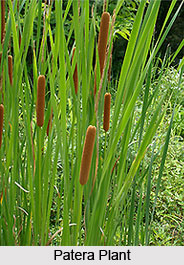 Patera is a robust, tall and marshy perennial plant found in India, which possesses high medicinal value. Patera is found in marshy habitats all over India at an altitude of about one 1700 meters. It is a major tropical grass. It is one of the highest yielding tropical grasses and a very versatile species that can be grown under a wide range of conditions and systems like dry or wet climatic conditions, smallholder or larger scale agriculture. This medicinal plant is also found in temperate and subtropical Europe, North America, Northern Africa and Northern Asia.
Patera is a robust, tall and marshy perennial plant found in India, which possesses high medicinal value. Patera is found in marshy habitats all over India at an altitude of about one 1700 meters. It is a major tropical grass. It is one of the highest yielding tropical grasses and a very versatile species that can be grown under a wide range of conditions and systems like dry or wet climatic conditions, smallholder or larger scale agriculture. This medicinal plant is also found in temperate and subtropical Europe, North America, Northern Africa and Northern Asia.
Different Names of Patera
The botanical name of this Indian medicinal plant is "Typha angustata Bory" and "Chaub". There are different names in different languages by which "Patera" is known all over India. This Indian Medicinal plant is known as "Hogla" and "Kaw" in Bengali language, "Panjabris", "Ghaba-Jario" and "Pario" in Gujarati language, "Maribala", "Anejondu", "Anechondu" and "Apu" in Kannada language, "Kai" and "Kundar" in Punjabi language, "Jambu", "Dabbujammu", "Jammugaddi" and "Jammu" in Telugu language, "Eraka" and "Gundra" in Sanskrit language, etc. This plant is known as
"Elephant Grass", "Bulrush" and "Reed Mace" in English language.
Nature of Patera
The flowers of Patera plant are minute, borne on cylindrical spikes 0.8 to 2.2 cm in diameter, the female and male spikes often widely separated on the stalk, at times on different plants; male spikes are 25 to 50 cm long, consisting of deep-yellow anthers; the female spikes of this plant are 22 to 38 cm long, pale brown, and the flowers are mixed with clavate pistil lodes. Fruits of Patera are fusiform, dehiscent by an apical lid. Patera grass is very similar in appearance to sugarcane but its leaves are narrower and its stems are taller.
Yellowish or purple in colour, the stems are coarse and hairy, and about 1 inch thick near the base. This makes stands of Patera nearly impenetrable. The leaves are 2 to 3 feet long, pointed at the ends, and about 1 inch wide. The edges of the leaves are razor-sharp. The leaves are flat, linear and hairy at the base, up to 100-120 cm long and 1-5 cm wide, bluish-green in colour. Spikelets are arranged around a hairy axis and fall at maturity. There is little or no seed formation. When seeds are present they are very small.
Use of Patera
Patera is very important forage in the tropics due to its high productivity. It is particularly suited to feed cattle and buffaloes. Patera is mainly used in cut-and-carry systems and fed in stalls, or it is made into silage or hay. Patera can be grazed, provided it can be kept in lush vegetative stage; livestock tend to feed only on the younger leaves.
Patera is a multipurpose plant. The young leaves and shoots are edible by humans and can be cooked to make soups and stews. The culms can be used to make fences and the whole plant is used for thatch. Leaf infusions are reported to have diuretic properties. Patera has several environmental applications.
Historically, this wild species has been used primarily for grazing; recently, however, it has been incorporated into a pest management strategy. In addition to this, these grasses improve soil fertility and protect arid land from soil erosion. It is also utilized for firebreaks, windbreaks, in paper pulp production and most recently to produce bio-oil, biogas and charcoal. Many bird species make their home in the stands.
Medicinal Values of Patera
In Ayurveda, this Indian medicinal plant is regarded to be very useful for the treatment of urinary calculi, strangury, dysuria or mutrakrichha, erysipelas or visarpa and syphilis or firanga. The rootstock of the Patera plant is considered astringent or sour or bitter in taste and diuretic. The ash of the lower spikes of this medicinal plant of India is believed to encourage the healing of wounds. The young shoots of Patera, rhizomes and inflorescence are edible.



















